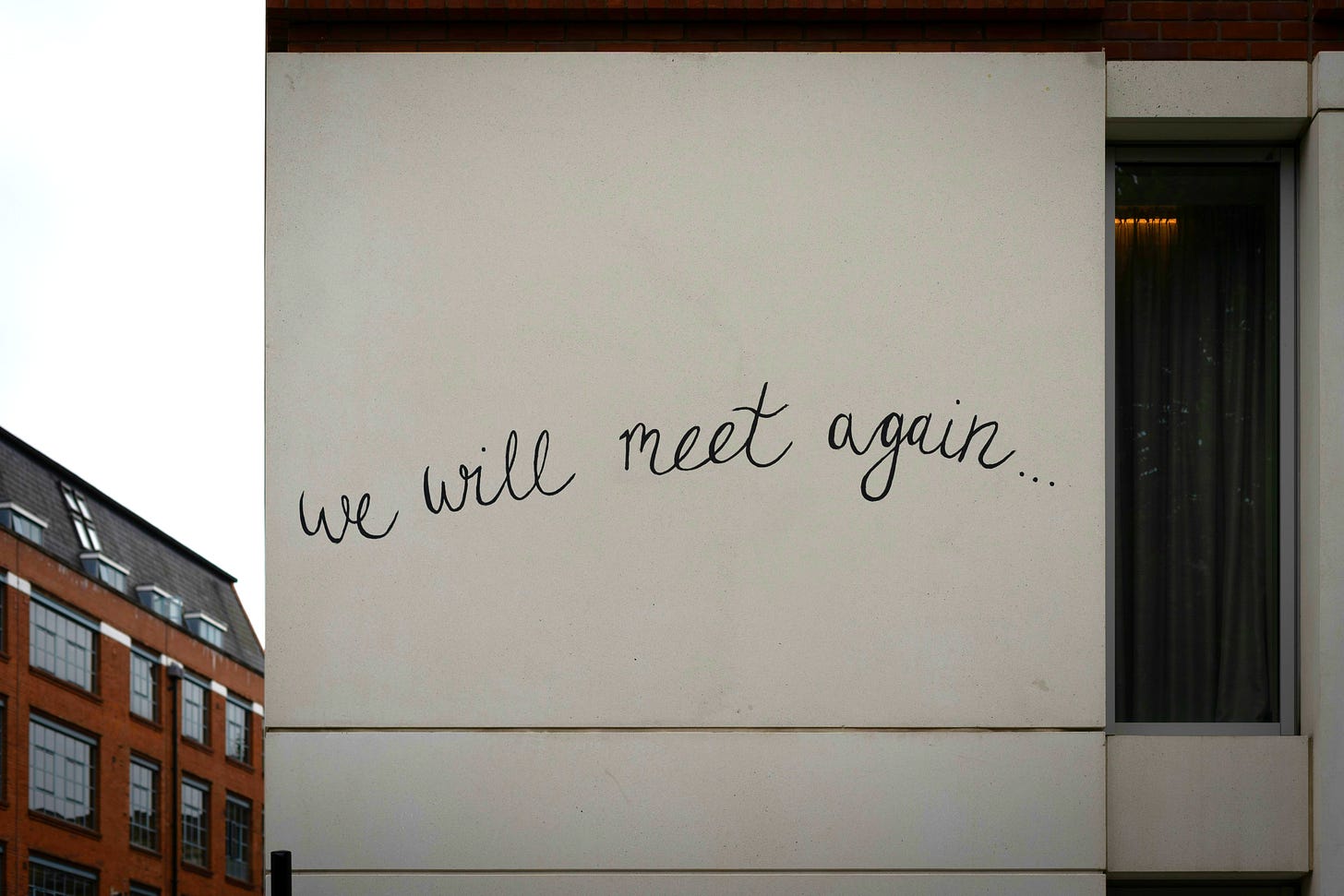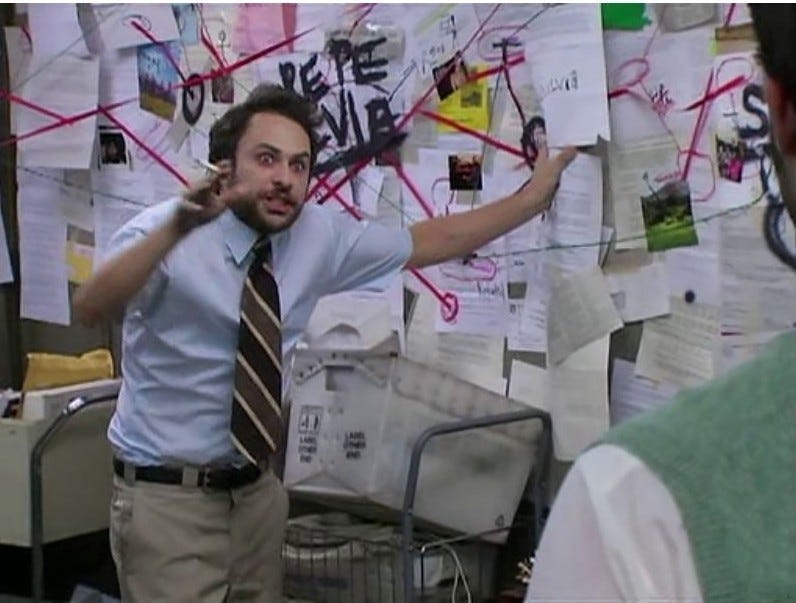Here We Go Again: Writing the 2nd Draft
You’ve written your first draft... Now it’s time to "actually" start writing your screenplay. Here’s my process for writing the second draft.
I haven’t been posting as much on Substack lately because I was writing the second draft of my fourth commissioned TV thriller film.

If you’re writing a TV movie, you will have a measly two weeks to write the second draft. While that doesn’t sound like a lot—and it really isn’t—if you’ve laid out the script with a stellar outline, it’s possible to make it through this frantic fortnight without losing years off your life.
I’ve written a lot about the importance of an outline for writing screenplays quickly. When you wield the outline to address plot concerns before going to draft, you will find that it has a ripple effect into your first, second and subsequent drafts.
Here I go into extreme detail about how I write my outlines and how they help me write my first (and ultimately second) drafts at lightning speed:
I realize it’s not always the goal to crank out a script: sometimes it’s fun to write a screenplay and savour every line without regard for a timeline. But if you want to save some cost of your own labour, approaching your second draft this way can help.
Rewrites: Additive vs. Subtractive
To borrow a term from sculpting, there are two kinds of screenwriters when approaching rewrites: Additive and Subtractive.
Additive screenwriters are the ones who fly through the first draft, getting only the most important framework on the page, which usually results in a shorter first draft. During the second draft, they’ll build up the script. As they rewrite, each scene begins to fill out, two-dimensional characters start to become more life-like and functional dialogue gets some finesse.
Subtractive screenwriters do just the opposite: they overwrite the first draft, including every idea and flight of fancy. When they hit the second draft, they need to pull out the chisel to knock down prose-like action, overwritten scenes, drawn out interactions, superfluous dialogue and anything that doesn’t move the story forward.
I’m an additive screenwriter, so I find it easier to add muscle and skin to the skeleton of my first draft, but there is no right or wrong way to approach the second draft.
It’s entirely up to you!
How I write my second drafts
I’ve written a lot of second drafts in my 15+ years of screenwriting. For me, it somehow feels more daunting than the first, probably because it turns me into this:

As you can see, for my own sanity, I needed to come up with a system.
You’ll see in the steps below that the preparations for your second draft actually begin much before you start rewriting…
Step 1 : Number the scenes of your first draft
You’ve finished your first draft and you’re as happy as anyone finishing a first draft can possibly be.
The last thing you’re going to do before closing that file is NUMBER YOUR SCENES. In Final Draft you’ll find this under Production > Scene Numbers.
This minor task gets its own step so you don’t forget to do this! Forgetting to reset my scene numbers at the end of each draft has cost me so many headaches.
Scene numbers are extremely important for the next step…
Step 2 : Send out your first draft for notes
Before you write your second draft, you’re going to have to have an idea of what you need to change.
I am a huge believer that someone, somewhere should read the first draft of your screenplay and give you *some* notes on it. This could be from a trusted colleague, friend or even a family member.
It’s so easy to lose the forest for the trees when you’re writing your first draft. Sometimes glaring plot holes go completely unnoticed when you’re in the thick of it, so getting an outside look can give you more of a bird’s eye view of your story.
Even better, you could get notes from a professional who has knowledge of the craft in the from of script coverage. Whichever way you go, in order for the above people to give you accurate notes, they’re going to need to reference the scene numbers.
You might be thinking: Who cares about scene numbers? They can just give me the page number in their notes! This works fine until you actually start editing and then page 14 is now split between pages 18 and 19 and you start feeling like Charlie (see image above). If you add scenes in between, the original scene number will never change until you manually change it so it’ll never throw you off!
I’m lucky because all four of the TV movies I’ve written/am writing were commissioned scripts: I was hired to write an existing pitch, or I pitched the idea myself and it was greenlit. This means that I am always working together with a development executive throughout the process.
I get notes from my exec at the end of every phase: Pitch, outline (however many drafts we need), first draft, second draft, third draft… all the way to the polish. And after that begin the production/directorial notes as the film moves into pre-production.
If you don’t have the luxury of build-in notes from a seasoned exec, fear not! We’ll cover that in Step 4. Until then, Cut To:
Step 3 : Recover from your first draft
Before you dive into your second draft, the best thing you can do is give yourself time and space. You just birthed your first draft and you need time to recover. Work on other projects, watch a bunch of movies, read some books… anything but thinking actively about your script.
I find when I give myself time away, my subconscious will naturally wander to the script and start unraveling issues that I am painfully aware exist in my first draft. When I have these aha moments during a break, I simply make note of these revelations so that I can come back to them when I dive into rewriting.
The break between the first and second draft as a writer of TV movies is short… pretty much as long as it takes your exec to get you notes back. I’ve had “breaks” as little as 1 or 2 days between drafts, so if you’re writing a spec script or something with a more flexible timeline, please take at least a week!
If you’re like me, this break can be confusing and even frustrating because it can feel like you’re willfully procrastinating. It’s taken me a long time to learn how to relax and rest my brain during these in between periods (truthfully, I’m still not great at this).
I’ve written before about how, if you don’t let it, your mind will carve out time to process, whether you like it or not. I used to think this was just uncontrollable procrastination, but now I know that I shouldn’t fight my mind’s natural need to reset:
Ok, so now that it’s been a week, a month, a year! break’s over and we can Cut To:
Step 4 : Internalize the notes you receive
If you’re working on a commissioned script, your notes are probably going to be more detailed than they would be coming from a friend or colleague. Same goes for if you’ve paid for professional script coverage.
For my first draft, I will usually get a page of general considerations and overarching feedback as well as about 5 - 7 pages of detailed, scene-by-scene notes. The reason TV movie execs are so granular even with the first draft is that it expedites the writing process and works to nip any potential issues in the bud at the second draft phase.
Being efficient with notes and implementing them quickly is all in an effort to save costs: The more detailed the notes, the less overall drafts will be needed (at least that’s the hope!), the faster the development process, and the sooner the film can get into pre-production and go to camera.
If you already have notes, now is the time to internalize them. By that I mean that you should really absorb the core of the notes you acquire, whether you’re going to implement them or not. While not all notes are worthy of being implemented, all notes come from a potential-viewer’s perspective.
This means that while they may not jive with what you’re trying to do, they offer valuable perspective and should still be mulled over. I usually internalize notes by giving them an initial read and then reading them a few more times over a couple days as I amp myself up to get working on that second draft.
OPTIONAL : Give yourself notes
If you don’t have anyone to give you this level of detailed notes, you can become your own “development exec”. You do this by distancing yourself from the story and looking at it from a more critical angle. The longer the break you’ve taken, the easier it becomes to gain perspective.
Honestly, I’d still recommend doing this even if you have received notes, because it helps you organize your thoughts and plan your approach to draft two.
Here’s how to give yourself notes:
Read your first draft but pretend it’s someone else’s work
Make general notes about the overarching story and script
Make note of any inconsistencies or plot holes
Go through the script scene by scene (either on paper or digital) and make scene notes: These can be big story notes or small edits
Identify overarching themes and make note of them
Resist the urge to start making changes as you’re going through: This is “someone else’s” script, remember?
Now you should have a big list with general notes at the top and detailed notes down below. Read this list one final time as a whole before you start on your second draft.
Step 5 : Start the first pass
When I write my second or subsequent drafts, I always have the Final Draft file open on the left half of my screen and the notes in a word document on the right. I like seeing both at once so I never forget to implement a note because they are always staring me in the face.
As I work through a note and am satisfied that I have indeed made the appropriate rewrite, I change the colour of that note in the word doc from black to light grey. This way, my eyes can skip over any notes that are already implemented without deleting them from my notes doc. And it makes whatever is still left to be changed stand out.
Some notes are harder to implement than others, so I usually like to do the quick-wins first to ease myself into the process and get me feeling optimistic about draft two. This means, implementing simple notes like fixing typos, changing single lines of dialogue, or fixing anything that can be resolved within a single scene.
If there are any notes my exec gives me that I’m not going to implement, I first copy them into an blank email and then make them light grey in my notes list too. In the email, I write a little explanation of why the note isn’t going to work and why I’m not going to take it.
If you’re writing for (the promise of) money, you need to be able to justify why you won’t take a note from within the context of the story (“cause I don’t feel like it” is not a reason to pass on a note, no matter how badly you want to scream it!)
Now you’ve made a lot of changes, you can see a lot of light-grey notes on your word doc and you’re feeling like “I can do this!”. Use this high to Cut To:
Step 6 : Do the second pass
This second sweep of the script is more of a deep carpet cleaning.
You’re going to start implementing the larger notes that stretch across multiple scenes, or what I like to call “domino notes” or “butterfly effect notes”. These can be general notes about characterization, the relationships between the characters, plot points that you’ve discovered aren’t actually working in draft, etc.
If you gave yourself notes, you’ll also take this pass to start injecting or heightening the theme you wrote down in step 4. How can you better articulate your theme through your characters?
If you’ve outlined well, I promise you that there will be less domino notes! That’s because you’ve taken the time to work on any potential hiccups in forensic detail. If you’ve got a solid outline, you shouldn’t encounter any notes that would spell a page one rewrite!
Work through these notes until your word doc of notes is completely light grey and everything you (or your note-giver) has included has been dealt with to your satisfaction.
Step 7 : Read it over again (and again and again)
Now that you’ve implemented all of your notes, you have to go back through and ensure that things still make sense. Sometimes you’ll discover on this read-through that you didn’t actually implement a note fully.
An example of this would be finding something that should have been changed due to a domino note but wasn’t addressed yet.
Example: I have a note that directly impacts scene 30 but I forgot that the thing I changed is previously mentioned in scene 7. Reading through helps you catch all those loose tendrils.
Now just read it again 10 more times until you can barely stand looking at it!
Step 8 : Deciding when to stop
The second draft is still a work in progress. You’re not going to solve everything. Your dialogue is not going to be perfect. Your characters might still feel a bit wooden. Their voices might still sound kind of generic. These are all things that you’ll work on honing in the third and subsequent drafts.
For the second draft, the most important thing is to make sure everything is in the right place and the story is holding itself up. I like to consider my second draft as kind of the equivalent of a “picture lock” in film editing. All of the pieces are where they need to be, now comes the colouring, sound, music, and all the other things that make the film magical.
The way I determine when I am done with any draft is when I can read it through and don’t get snagged by anything.
I’ve implemented my notes to my liking, there aren’t any glaring errors, and I can read it through from start to finish smoothly without stopping.
What’s left? For the love of all things good, renumber your scenes!
Now, go take a much deserved break after draft two before you dive into draft three!
Do you need notes on your first draft? I can help you with that! Let’s talk!






Great post, Lauren. Rewriting is tough work, but your process is extremely helpful.
All great tips.